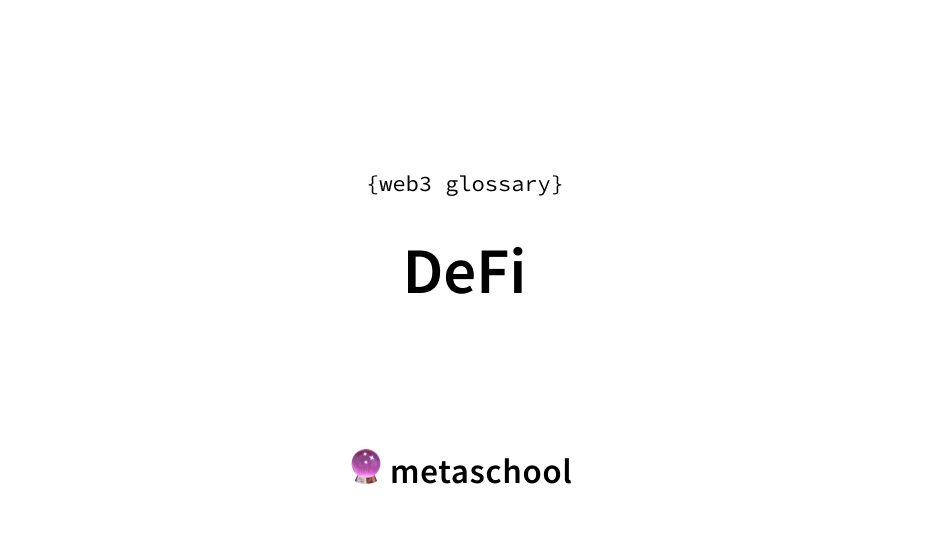Table of Contents
What is DeFi?
Decentralized Finance, commonly referred to as DeFi, is an ecosystem of financial services that run on top of a blockchain network such as Ethereum. The purpose of DeFi is to offer a more open and transparent financial system that is not controlled by any single entity or institution.
Origins of DeFi
The concept of Decentralized Finance was proposed in 2018 by a group of entrepreneurs and Ethereum developers who wanted to free finance applications and services from traditional systems, again, like banks.
DeFi structure
DeFi is built on the principles of decentralization, meaning that financial services are provided without the need for a central authority, such as a bank or a government. Instead, users can access these services directly on the blockchain, without the need for a third party. This allows users to interact with the financial system without having to trust any centralized authority.
DeFi is a new way of providing financial services on public blockchains. It enables users to access a variety of financial services, such as loans, trading, insurance, and more, all without relying on a centralized entity. Instead, these services are provided by a network of smart contracts secured by the blockchain.
It is still relatively new, and there is a lot of experimentation and innovation happening in the space. DeFi protocols are being built to provide more efficient, secure, and cost-effective financial services. As these protocols are built and adopted, they will create new opportunities for users to access and manage their finances in a more open and secure manner.
DeFi features and benefits 🏦
The main benefits of DeFi are that it is open and transparent, and that users can access financial services without needing to trust a third party. This is a significant improvement over traditional financial services, as users no longer need to provide personal information to access them.
- Earning interest
- Borrowing
- Trading derivatives
- Trading assets
- Buying insurance
and much more, but the best thing is that it is much faster and does not require paperwork or a third party like banks.
Protocols 🖇
In the past few years, there has been massive growth in DeFi protocols. These protocols are specialized autonomous programs that have been launched to resolve issues in our traditional finance industry. It is especially to pay the fees that banks and other financial companies charge for using their services.
Users can directly
- Interact with their assets
- Transfer their funds in minutes to anywhere in the whole globe
- Hold money in a secure digital wallet
DeFi and blockchain are real and novel technologies that can be applied to both public and private sectors, permissioned or non-permissioned.
– Chase Jamie Dimon, Chairman and CEO JPMorgan Chase
DeFi challenges 🤔
Although DeFi’s contributions toward finance are significant, there have been some challenges for it like:
- Limited consumer protection
The challenge of consumer protection arises with the lack of regulatory measures with respect to decentralized systems. DeFi protocols such as smart contracts are not always foolproof. Because there is no central authority, users highly rely on such protocols. The lack of a centralized authority can sometimes cause some vulnerabilities. This is why DeFi can pose challenges to users.
- Collateralization
Collateralization in DeFi can be a challenge for a new crypto user because it involves putting up digital assets as collateral to borrow other digital assets. This can be risky if the value of the collateral falls below a certain threshold, which can lead to the loss of funds. Again, this collateralization is done by smart contracts. The lack of a centralized authority can pose a challenge. However, it is important to understand that DeFi is a work in progress and that such challenges are only temporary.
- Liquidity concerns
The decentralized nature of liquidity in DeFi means that it there is a chance that it can be unevenly distributed. This uneven distribution can lead to price volatility and slippage when trading or borrowing. If there are not enough users providing liquidity to a particular pool, it can be difficult to execute trades or borrow funds at a reasonable price.
To tackle these issues developers have improved and developed DeFi 2.0, a version that solves the challenges mentioned above. It overcomes its former’s limitations and makes the entire ecosystem more efficient, secure, and conducive for newer and highly diverse use cases.
Major DeFi Projects 💹
The Global Decentralized Finance market is expected to reach $16.33 billion in 2023. That’s no surprise considering that after cryptocurrency, DeFi is considered to be the most profitable use-case of blockchain technology.
Decentralized Finance is going to eliminate the service charges that banks receive, which is their main source of income. Banks will now have to think of different ways otherwise they may struggle to compete… or even survive.
Overall, DeFi is an exciting and innovative ecosystem that is quickly gaining traction. It has the potential to revolutionize the way we access and utilize financial services in the future. As the DeFi ecosystem continues to evolve, we will continue to see more innovative applications and services emerge.
